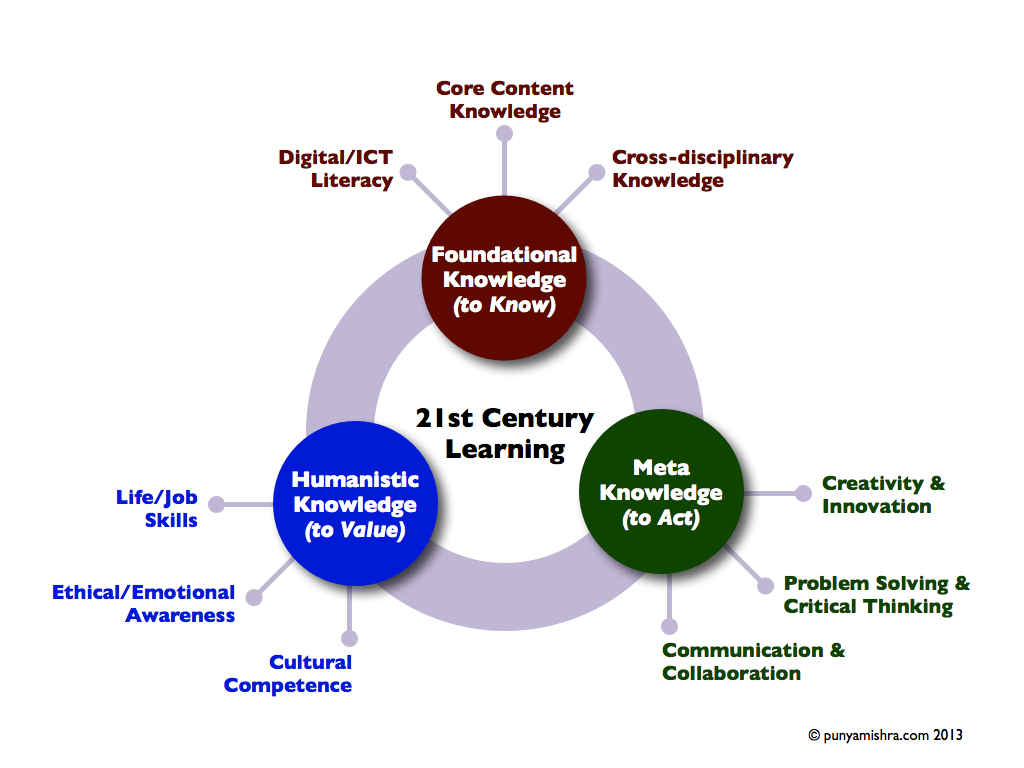

from The TeachThought staff
Thinking in the 21st century it’s just different.
This does not mean that we all suddenly become all-powerful cyborgs, nor that we all become mindless social media addicts who expend our cognitive power tapping, swiping and drooling over our smartphone and tablet screens.
But just as the 19th century presented unique challenges to information processing compared to the 18th or 20th, the 21st century is unlike any that came before it or any that will come after it.
punyamishra.com recently released the following graphic which I found interesting. He identifies types of knowledge for modern learning, focusing on fundamental, humanistic and meta knowledge.
3 areas of knowledge for the 21st century student
1. Basic knowledge (to know)
Digital/ICT literacy, basic content knowledge, interdisciplinary knowledge
Summary
This area covers the basic concepts and principles that form the basis of various fields of study. It includes subjects such as math, science, history, and language arts. Core knowledge provides the framework for understanding more specialized areas of knowledge and is critical to critical thinking, problem solving and communication skills.
Examples of fundamental knowledge
Example 1: In a math classroom, students can learn basic concepts such as addition, subtraction, multiplication, and division through hands-on activities such as visualizing math operations using manipulatives (such as blocks or counters).
Example 2: Teachers can introduce basic chemistry knowledge by conducting hands-on experiments to investigate the properties of various elements, compounds and chemical reactions, such as mixing acids and bases to observe changes in pH.
Example 3: Teachers can introduce basic knowledge of world history by analyzing timelines and maps to trace the major events, movements, and empires that have shaped global civilizations over time.
Example 4: Teachers can integrate humanistic knowledge by analyzing characters, motivations, and ethical dilemmas presented in literary texts, encouraging students to empathize with different perspectives and experiences.
Example 5: Students can learn about basic concepts in physics by conducting experiments to understand Newton’s laws of motion using simple materials such as ramps, balls, and spring scales.
2. Humanistic knowledge (to be assessed)
Life/work skills, ethical/emotional awareness, cultural competence
Summary
Humanistic knowledge focuses on the study of human experience, values, and cultures. It includes disciplines in literature, philosophy, art, religion and ethics. Humanistic scholarship helps people explore questions of meaning, identity, morality, and social justice, fostering empathy, creativity, and a deeper understanding of the human condition.
Examples of humanistic knowledge
Example 1: Students can use creative writing exercises to express their thoughts, emotions, and insights, drawing inspiration from literary works and personal experiences to explore themes of identity, belonging, and self-discovery.
Example 2: Teachers can facilitate philosophical discussions about timeless questions such as the nature of reality, the meaning of life, and the existence of free will by encouraging students to critically examine their own beliefs and assumptions.
Example 3: Students can engage in debates and Socratic dialogues to explore ethical dilemmas and moral reasoning, applying philosophical concepts to real-world problems and making ethical decisions.
Example 4: Teachers can integrate humanistic knowledge by encouraging students to create artwork inspired by beauty, love, struggle and transformation, using different media and techniques to express their ideas and emotions.
3. Meta knowledge (for action)
Creativity and innovation, problem solving and critical thinking, communication and collaboration
Summary
Meta-knowledge refers to knowledge about knowledge itself—the processes, structures, and strategies involved in acquiring, organizing, and evaluating information. It includes critical thinking skills, information literacy, research methodologies and metacognition. Meta knowledge enables people to become lifelong learners, adapt to changing environments and make informed decisions in a rapidly evolving world.
Examples
Example 1: In any subject area, teachers can incorporate critical thinking skills by asking open-ended questions that require students to analyze information, evaluate evidence, and construct reasoned arguments supported by evidence and logic.
Example 2: Teachers can use case studies or real-world scenarios to challenge students to apply critical thinking skills to complex problems and decision-making situations, encouraging them to consider multiple perspectives and weigh the consequences of their choices.
Example 3: Students can use metacognitive tools such as concept maps, graphic organizers, or study journals to organize and review their thoughts, connect new information to prior knowledge, and identify patterns or gaps in their understanding.
Using this model in your classroom
The easiest way to use this kind of model in your classroom is to think of it as a framework for planning, whether at the unit, lesson or activity level. Thus, you could try to achieve a balance between the three knowledge areas, or one unit that is strongly aligned with humanistic knowledge (for example, a novel study of To Kill a Mockingbird), while another project-based unit of study focuses on metaknowledge.
But on a broader and perhaps more subjective level, this graphic can serve as a simple reminder that our job as teachers is to help students understand how to know, value, and act, even though most of them seem to go beyond the ordinary classroom assessment tools room.
The concept of domains of knowledge can support the development of critical thinking skills. Students can learn to analyze and evaluate information, identify patterns, and make inferences by engaging with domains (one of many) as foundational knowledge. Humanistic knowledge promotes empathy, perspective-taking, and the ability to consider different perspectives, while meta-knowledge promotes metacognition, information literacy, and the ability to think reflectively about one’s own thought process.
The big idea of all learning can then begin with knowledge leading to assessment that informs action in relevant and authentic communities.

